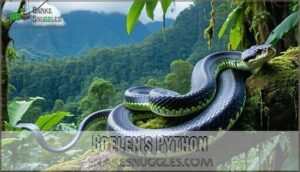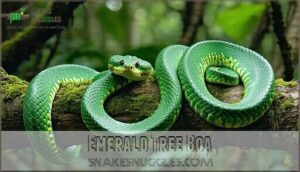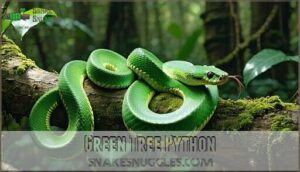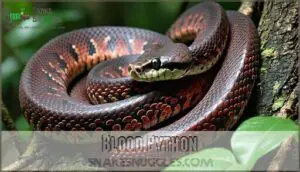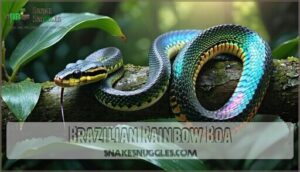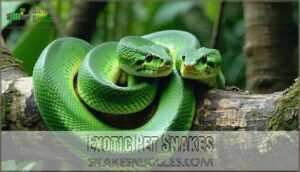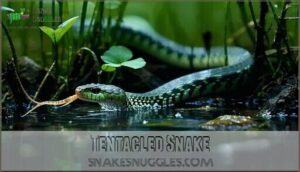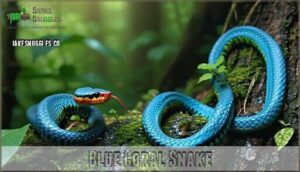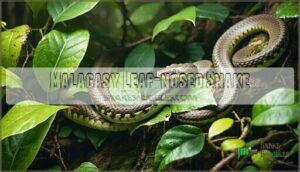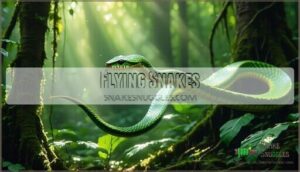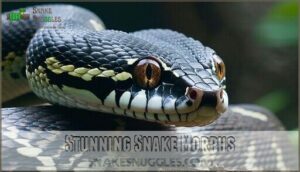This site is supported by our readers. We may earn a commission, at no cost to you, if you purchase through links.
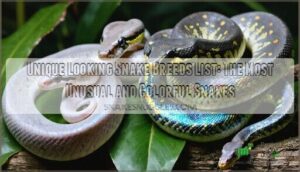
Ball pythons steal the show with their incredible morphs – think leucistic whites, piebald patches, and iridescent scales that shimmer like oil on water.
Brazilian rainbow boas practically glow with their holographic sheen, while emerald tree boas sport that coveted jade coloration.
For something truly wild, scaleless snakes feel like living leather, and lavender albinos look almost otherworldly.
Don’t overlook the blood python’s deep burgundy hues or the green tree python‘s lightning-bolt patterns.
Each species brings its own genetic surprises that’ll make you question what’s even possible in reptile genetics.
Table Of Contents
- Key Takeaways
- Unique Snake Patterns
- Rare Snake Breeds
- Exotic Pet Snakes
- Colorful Snake Species
- Stunning Snake Morphs
- Frequently Asked Questions (FAQs)
- What is the most unique snake?
- What is the rarest breed of snake?
- What is the coolest looking snake?
- What is the most exotic snake you can own?
- What care requirements do unique snakes need?
- How much do rare snake breeds cost?
- Are exotic snakes legal to own everywhere?
- Which unique snakes are best for beginners?
- How long do colorful snake species live?
- Conclusion
Key Takeaways
- You’ll find incredible genetic diversity in unique snake breeds, from iridescent Brazilian rainbow boas with holographic sheens to leucistic ball pythons displaying pure white scales with normal eyes.
- Rare morphs and patterns create stunning visual effects through microscopic ridge formations, scaleless textures, and color mutations like axanthic genetics that eliminate yellow pigments for striking monochromatic displays.
- Exotic species offer manageable pet options with corn snakes, ball pythons, and Brazilian rainbow boas providing beginner-friendly care requirements while showcasing remarkable colors and patterns.
- Specialized adaptations make these breeds extraordinary – from tentacled snakes with facial appendages for underwater hunting to flying snakes that glide 300 feet between trees using flattened body mechanics.
Unique Snake Patterns
You’ll spot snake breeds that wear their colors like royalty, from shimmering iridescent scales to piebald patches that look hand-painted by nature.
Taxonomists might call these features “genetic mutations,” but you’ll probably just call them mesmerizing—unless you happen to own socks with leopard spots, in which case, you may have competition from snakes with iridescent scales.
Iridescent Scale Patterns
Ever seen a snake shimmer like a living CD under sunlight? That’s all down to iridescent scale patterns.
Thanks to scale nanostructures and light refraction, certain unique snake breeds, like the sunbeam snake, look rainbow-bright at every twist.
Nature’s tiny architects craft rainbow scales through microscopic ridges that turn sunlight into living jewels.
These snakes are commonly found in Southeast Asia.
Iridescence genetics shape their colors, and angle dependency means one moment they’re subtle, the next they’re stealing the show—evolutionary advantage, indeed!
Lavender Albino Patterns
From shimmering scales, let’s meet Lavender Albino patterns—a standout in unique snake breeds.
Thanks to Albino Genetics, these snakes show off dreamlike lavender hues, red eyes, and sharp pattern variations.
Ready for a breeding challenge? Producing Lavender Albino ball pythons isn’t easy, but their vibrant snake coloration and rare genetic variations make them show-stoppers for collectors and science fans alike.
These snakes often exhibit photophobia due to albinism, requiring specific habitat considerations.
High White Piebald Patterns
You’ll quickly spot High White Piebald patterns in Ball Pythons—bold, dramatic white patches interrupted by spots and shapes, sometimes resembling awkward leopard dances.
These unique snake breeds display:
- Inheritance rarity from complex Pattern Genetics
- Exceptional breed variation
- Striking Aesthetic Appeal
- Leopard shapes in color patches
- A poster child for rare snake varieties and unique snake patterns!
Scaleless Patterns
If you’re hunting for a showstopper, scaleless patterns top the list.
Scaleless snakes reveal their color genetics with smooth skin that amps up pattern visibility. Genetic disruption in scale development delivers unique aesthetics—no two scaleless snakes look alike.
These rare, unique snake breeds show the wild side of genetic variations, proving snake patterns can really break the mold. These snakes’ smooth skin highlights unique pattern formation, which is a key aspect of their unique appearance and genetic variations.
Leucistic Patterns
While scaleless patterns offer smooth beauty, leucistic patterns create nature’s ghosts through stunning genetic mutations.
These leucistic snake breeds showcase pure white or pale coloration with normal eye color, unlike albinos.
Here are key leucistic pattern characteristics:
- Leucism genetics involve recessive gene mutations blocking pigment production
- Visual impairment typically doesn’t occur since eyes retain normal coloration
- Breeding challenges arise from recessive inheritance requiring specific genetic pairing
- Conservation status varies, with some leucistic examples facing habitat threats
- Leucistic examples include Texas Rat Snakes and Ball Pythons displaying ethereal white snake patterns
These unique snake breeds demonstrate remarkable snake coloration variations through complex genetic mechanisms.
Rare Snake Breeds
You’ll discover some of nature’s most extraordinary serpents in this collection of rare snake breeds that showcase stunning colors and unique physical features.
These remarkable species combine breathtaking beauty with fascinating adaptations that make them highly sought after by reptile enthusiasts and researchers alike, showcasing unique physical features.
Boelen’s Python
You’ll find Boelen’s Python among the most coveted rare snake breeds worldwide.
This New Guinea native showcases stunning iridescent scales that shimmer with blue and purple hues against glossy black coloration.
Found exclusively in mountain forests at high elevations, these exotic snake species require specialized captive care due to their unique environmental needs.
Their conservation status remains concerning, with extremely limited breeding success making them incredibly valuable in herpetoculture.
Ethical ownership can aid in rare snake preservation and support the preservation of these exotic species.
Emerald Tree Boa
You’ll recognize the Emerald Tree Boa by its vibrant green coloration and distinctive white lightning pattern zigzagging across its body.
These South American rainforest specialists showcase perfect arboreal adaptations with their prehensile tails and heat-sensing pits.
Nature’s rainforest acrobats come equipped with built-in climbing gear and thermal vision.
Their emerald scales provide exceptional rainforest camouflage, making them nearly invisible among tropical foliage.
Unlike some exotic snake species, they don’t undergo ontogenetic shift, maintaining their stunning appearance throughout life.
Green Tree Python
You’ll love Green Tree Python’s remarkable arboreal adaptations and prehensile tail that make navigation through rainforest branches effortless.
These colorful snake breeds showcase stunning ontogenetic coloration, transforming from bright yellow or red juveniles into emerald adults with perfect rainforest camouflage.
Their unique snake breeds require specialized captive care with proper humidity and climbing structures.
Blood Python
Blood pythons captivate with their rich color morphs featuring burgundy, maroon, and bright red markings.
Their stout bodies showcase remarkable snake markings that make them highly sought after. These unique snake breeds display stunning genetic variations in their distinctive snake patterns.
Despite their docile temperament, their specific care requirements include proper humidity and temperature.
Conservation efforts protect their Southeast Asian habitat from declining populations, which is crucial for the conservation of these species and their unique genetic variations.
Brazilian Rainbow Boa
You’ll discover the Brazilian Rainbow Boa’s iridescent sheen creates a living kaleidoscope effect across its scales.
These semi-arboreal lifestyle enthusiasts display stunning leopard patterns through complex color genetics.
Their manageable size makes them perfect for enthusiasts seeking unique snake breeds with extraordinary iridescent scale patterns.
These serpents transform ordinary light into spectacular rainbow displays through their unique snake markings.
Exotic Pet Snakes
If you’re looking for a fascinating pet snake that’ll turn heads and spark conversations, exotic breeds offer some of nature’s most stunning displays of color and pattern.
These remarkable serpents combine manageable care requirements with breathtaking appearances that range from iridescent rainbows to striking morphs you won’t find in typical pet stores, showcasing breathtaking displays.
Ball Pythons
Exploring Ball Python morph genetics reveals nature’s artistic mastery in unique snake breeds.
These docile reptiles showcase incredible genetic variations, from spider morphs to leucistic patterns.
Their feeding habits involve consuming rodents monthly, while enclosure enrichment requires hiding spots and proper heating.
Breeding challenges include temperature cycling and pairing compatible morphs.
Many keepers enjoy exploring various Ball Python morphs for their collections.
Conservation efforts protect wild populations from habitat loss, making captive breeding programs essential for preserving these remarkable unique snake markings, which are a result of Ball Python morph genetics and showcase incredible genetic variations with leucistic patterns.
Corn Snakes
Corn snakes (Pantherophis guttatus) showcase nature’s artistry through breathtaking corn snake morphs.
You’ll find scaleless corn snakes with smooth skin highlighting their intricate snake patterns, while the Palmetto Corn Snake displays cream bodies with red speckles.
Many owners enjoy browsing available corn snake morphs online.
- Orange flames dancing across amber scales
- Snow-white bodies contrasting with ruby-red eyes
- Lavender hues blending into pearl undertones
- Leopard-like blotches creating wild masterpieces
Texas Rat Snakes
Texas Rat Snakes showcase remarkable habitat adaptation across diverse Texas ecosystems.
These masters of disguise display stunning color morphs ranging from yellow-gray to deep brown with distinctive blotched patterns.
Their conservation status remains stable, though regional differences create fascinating diet variations and unique snake breed identification challenges.
You can find essential snake products for Texas Rat Snakes online.
| Feature | Description | Notable Trait |
|---|---|---|
| Coloration | Yellow-gray to brown base | Dark blotched patterns |
| Size Range | 3-5 feet average | Robust, muscular build |
| Habitat | Woodlands to grasslands | Excellent climbers |
These snake breeds demonstrate incredible adaptability, with snake patterns varying substantially between populations.
Their unique snake breeds classification stems from their ability to thrive in multiple environments while maintaining distinct regional characteristics.
Long-nosed Vine Snake
How can a snake practically disappear in plain sight? The longnosed vine snake masters rainforest camouflage through its elongated snout and slender green body, perfectly mimicking vegetation.
This unique snake breed’s arboreal lifestyle keeps it motionless in branches until prey approaches. Diet specialization focuses on lizards and frogs, subdued by mild venom potency.
Snake identification becomes challenging due to exceptional snake camouflage and distinctive snake patterns. Some snake species, like the Brazilian Rainbow Boa, have iridescent scale patterns that shimmer in the light.
Dragon Snake
Moving beyond camouflaged hunters, you’ll find the dragon snake stands out among unusual snake types with its dramatic ridge-like scales.
This nocturnal hunter from Southeast Asian wetlands displays three pronounced rows of keeled scales, creating an unmistakable dragon-like texture that’s rare among snake breeds.
- Ridge-like scales create a prehistoric appearance that’ll make you think of ancient dragons
- Nocturnal hunter behavior means you’d catch glimpses during mysterious nighttime adventures
- Unique adaptations include body-stiffening defense mechanisms that seem almost magical
- Conservation status remains stable, though habitat loss threatens these rare snake breeds
Colorful Snake Species
You’ll find some of nature’s most spectacular displays in these colorful snake species, where evolution has created living art through vibrant patterns and unique adaptations.
These remarkable serpents showcase everything from tentacled appendages to gliding abilities, proving that snakes are among the most visually stunning creatures on Earth.
Tentacled Snake
From Southeast Asia’s murky waters emerges the tentacled snake, nature’s aquatic ambush specialist with snout appendages that detect prey movements.
This unique snake breeds member uses tentacled sensors for precise prey detection in Cambodia’s rice paddies.
Its unusual snake types morphology includes flattened bodies and unique adaptations perfect for underwater ambush tactics, making it one of the most distinctive aquatic snake species worldwide.
Banded Flying Snake
You’ll find banded flying snake gliding through Southeast Asian rainforests with remarkable aerial grace.
These unique snake breeds showcase vibrant banded patterns that provide excellent snake camouflage among forest canopies.
Their gliding mechanics involve flattening their bodies into aerodynamic shapes, demonstrating sophisticated arboreal locomotion.
Key characteristics include:
- Scale morphology features smooth scales that reduce air resistance during glides
- Predatory behavior involves ambushing lizards and frogs from elevated positions
- Conservation status remains stable due to adaptable forest habitat preferences
- Gliding mechanics allow distances up to 300 feet between trees
Blue Coral Snake
When you encounter this striking venomous snake species, you’ll notice electric blue dorsal stripes contrasting against a neon red head and tail.
Their diet specialization targets other venomous snakes, including young king cobras, and Blue Coral Snake venom composition features calliotoxin, creating instant paralysis in prey through unique sodium channel blocking.
Despite habitat preference for Southeast Asian forests, conservation status remains "Least Concern" despite significant habitat loss threatening these remarkable snake breeds.
Malagasy Leaf-nosed Snake
You’ll find the Malagasy leaf-nosed snake (Langaha madagascariensis) among unique snake breeds endemic to Madagascar’s forests.
This arboreal species showcases remarkable camouflage behavior, swaying like leaves to blend with vegetation.
Its distinctive nasal appendage helps it navigate its arboreal lifestyle while hunting.
Unfortunately, habitat loss threatens this specialized serpent’s conservation status in Madagascar’s diminishing woodlands.
Flying Snakes
Defying gravity’s pull, flying snakes showcase nature’s most extraordinary adaptations among unique snake breeds.
These remarkable snake species don’t actually fly but glide through rainforest canopies with impressive skill.
Their hunting techniques involve ambushing prey from above, making them masters of three-dimensional movement.
These snake patterns include vibrant bands that help with camouflage.
Key Features:
- Gliding Mechanics – Flatten their ribs to create wing-like surfaces for controlled descent
- Flight Distance – Can glide up to 300 feet between trees using undulating body movements
- Scale Adaptations – Specialized ventral scales provide aerodynamic control during their arboreal lifestyle
Stunning Snake Morphs
You’ll discover that snake morphs represent some of nature’s most spectacular genetic artistry, where selective breeding has revealed incredible variations like axanthic patterns that eliminate yellow pigments for striking black and white displays.
These stunning morphs showcase everything from leopard-like spots and classic diamondback patterns to pure snow-white specimens and microscopic ridge formations that create rainbow-like iridescence across their scales.
Axanthic Patterns
Witnessing axanthic genetics in unique snake breeds reveals nature’s artistic restraint through color absence.
These genetic variations eliminate yellow pigments, creating striking monochromatic patterns that showcase pure blacks, whites, and grays.
Pattern reduction enhances visual appeal by simplifying complex designs into elegant contrasts.
Breeding axanthics requires understanding recessive inheritance, where both parents must carry the trait.
Snake morphs result from genetic mutations.
Snake patterns become dramatically transformed, turning vibrant corn snakes into ghostly beauties and ball pythons into living sculptures of shadow and light.
Leopard-like Spots
Leopard-like spots create some of nature’s most striking patterned snakes.
You’ll recognize these distinctive markings in ball pythons and Brazilian rainbow boas, where spot patterns serve essential snake camouflage functions.
Leopard genetics produce varying spot morphs through complex pattern inheritance mechanisms.
- Mesmerizing rosette patterns that shift and dance across scales
- Bold contrast spots creating stunning visual drama against base colors
- Unique genetic combinations producing one-of-a-kind spot arrangements
- Natural camouflage artistry blending perfectly with dappled forest light
- Collector-worthy specimens showcasing rare leopard genetics in captive breeding
Diamondback Patterns
Revealing nature’s geometric artistry, diamondback patterns showcase intricate diamond-shaped markings that create stunning visual displays.
Eastern Diamondbacked Rattlesnake and Western Diamondbacked Rattlesnake exemplify these striking snake patterns through their distinctive scale structure.
You’ll notice how diamondback genetics influence pattern inheritance, creating remarkable color morphs that enhance snake camouflage.
These diamond patterns aren’t just beautiful—they’re evolutionary masterpieces that help unique snake breeds blend seamlessly into their environments, showcasing nature’s geometric artistry and stunning visual displays.
Snow-white Patterns
Snow-white morphs create breathtaking displays when albino genetics meet selective breeding.
You’ll find these pale beauties showcase frosty scales that seem painted with winter’s brush. Leucistic specimens display pure white bodies while maintaining normal eye coloration, contrasting dramatically with true albino snake breeds sporting red eyes.
- Corn Snake Snow Morphs – Creamy white bodies with faint yellow undertones
- Ball Python Leucistic – Pure white scales with black eyes and pink tongues
- High White Piebald Patterns – Striking white sections contrasting bold natural colors
Microscopic Ridge Formation
Beyond snow-white patterns lies nature’s engineering marvel: microscopic ridge formation.
You’ll find these nano structures create iridescent scales through precise ridge patterns on snake skin.
These microscopic textures aren’t just for show—they help snakes grip surfaces and move efficiently.
Scale formation varies by species, with some displaying leucistic traits while others showcase brilliant iridescent scale patterns that shift colors like tiny prisms.
Frequently Asked Questions (FAQs)
What is the most unique snake?
You’ll find the tentacled snake most unique – it’s the only snake with bizarre facial appendages that actually function as fishing lures, helping it catch prey underwater.
What is the rarest breed of snake?
The San Francisco garter snake stands among the world’s rarest, with fewer than 2,000 individuals surviving.
You’ll find this critically endangered beauty only in California’s San Francisco Peninsula, where habitat loss threatens its existence daily.
What is the coolest looking snake?
You’ll find the Brazilian Rainbow Boa absolutely stunning with its iridescent scales creating a living kaleidoscope effect, shimmering through purple, blue, and gold hues as light hits different angles.
What is the most exotic snake you can own?
You’ll want a Brazilian Rainbow Boa for stunning iridescence or a Leucistic Ball Python with striking white scales and normal eyes.
These captive-bred beauties offer exotic looks without extreme care requirements, making them perfect conversation starters.
What care requirements do unique snakes need?
Nearly 60% of exotic snake species require specialized humidity systems.
You’ll need precise temperature gradients, species-specific substrates, and controlled lighting cycles.
Many unique breeds demand live prey, quarantine protocols, and veterinary expertise for peak health.
How much do rare snake breeds cost?
You’ll pay anywhere from $100-$300 for most rare morphs like leucistic ball pythons, while ultra-rare specimens like high-white piebalds can cost $2,000-$10,000 or more depending on genetics.
Are exotic snakes legal to own everywhere?
No, exotic snake ownership laws vary dramatically by location.
You’ll need to check federal, state, and local regulations before purchasing any exotic species, as some require permits while others ban ownership entirely.
Which unique snakes are best for beginners?
Starting your serpent journey? You’ll want beginner-friendly breeds like corn snakes, ball pythons, or Brazilian rainbow boas – they’re docile, manageable, and showcase stunning patterns without complex care requirements.
How long do colorful snake species live?
Ball pythons typically live 20-30 years in captivity, while corn snakes reach 15-20 years. Brazilian rainbow boas average 20 years, and blood pythons can hit 30 years with proper care.
Conclusion
Discovering nature’s artistry through this unique looking snake breeds list reveals genetic masterpieces that seem painted by an otherworldly brush.
You’ve explored species ranging from iridescent Brazilian rainbow boas to ethereal leucistic ball pythons, each displaying remarkable adaptations.
These serpents showcase evolution’s creativity through scaleless textures, holographic sheens, and vibrant morphs.
Whether you’re captivated by emerald tree boas‘ jade brilliance or blood pythons’ burgundy depths, these extraordinary reptiles demonstrate that nature’s palette knows no bounds in creating stunning, unforgettable creatures, revealing the beauty of nature’s artistry.
- https://a-z-animals.com/blog/11-coolest-looking-snakes-in-the-world/
- https://www.color-meanings.com/colorful-snakes/
- https://www.reddit.com/r/snakes/comments/1ed5w47/any_similarly_colored_bright_snakes_that_wont/
- https://www.zillarules.com/articles/types-of-pet-snakes
- https://www.discoverwildlife.com/animal-facts/reptiles/weirdest-snakes-in-the-world

